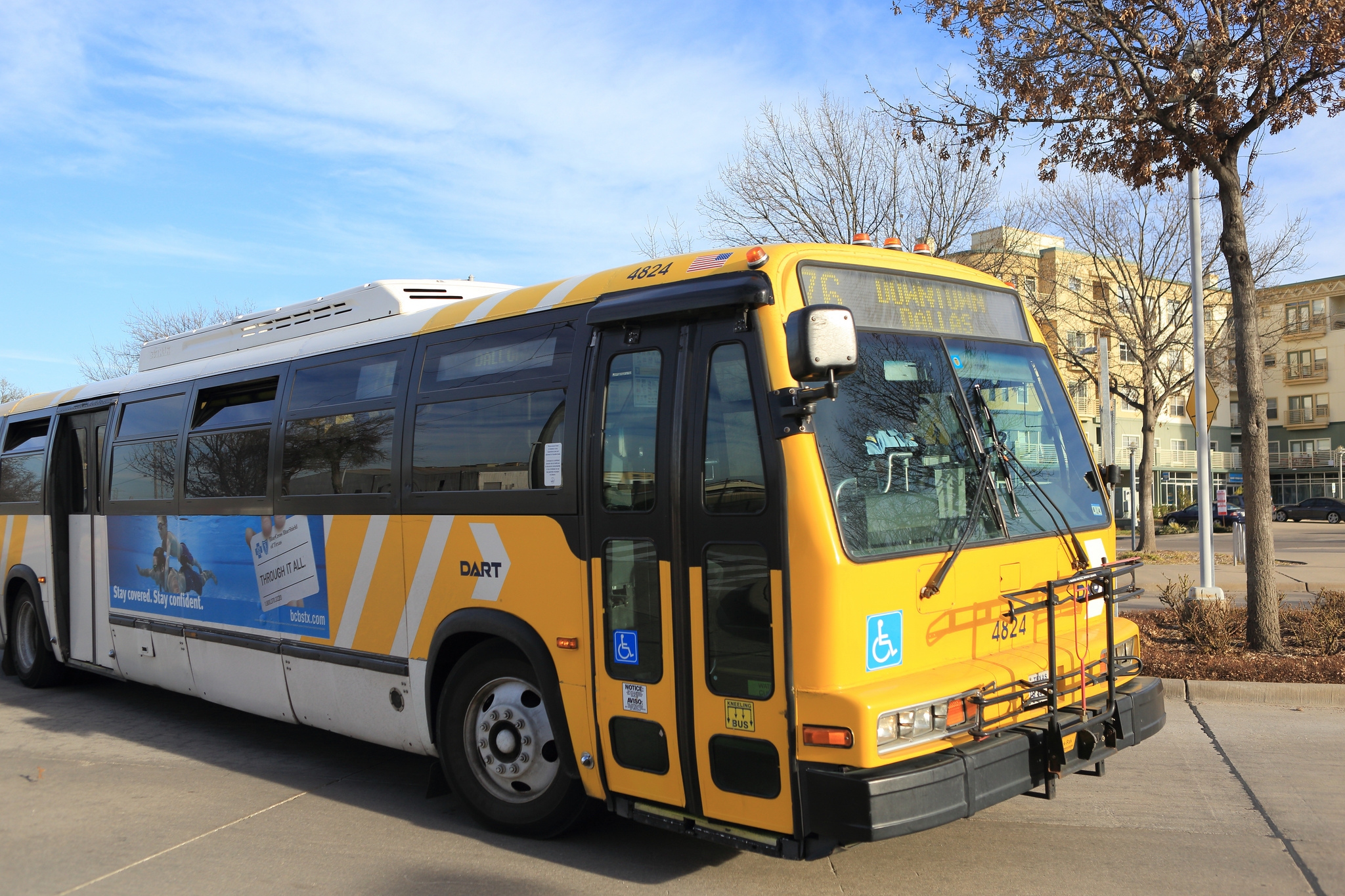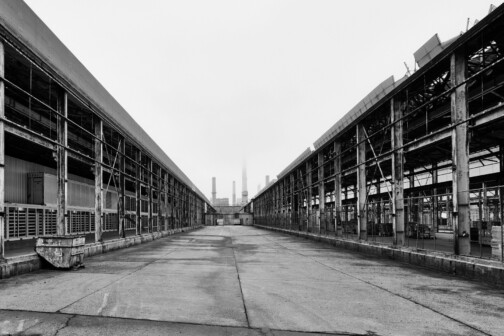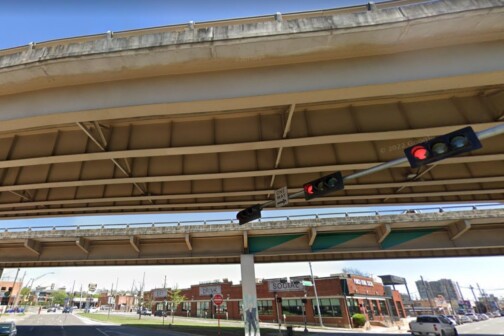People often say one good measure of a city’s humanity is the success of its public transit. That kind of thinking is why every time I visit a new city, I take the bus or train at least once. And most of the time when I arrive back in Dallas, I am disappointed. Nothing brings me back to reality faster than off-boarding a plane then getting on Dallas Area Rapid Transit for an hour-plus commute from DFW back to my apartment.
Last week, though, those DART buses started to move a little faster.
DART implemented its new bus network last Monday, which routes more buses on its most used corridors. The trade-off for riders is that you might have to walk a longer distance to a bus stop, but your bus is more likely to show up on time. DART has cut some routes to put more buses onto 22 core frequency routes, which run every 2o minutes mid-day and 15 minutes during peak times.
Anecdotally, connections between most buses feel tighter, and certainly the connections between buses and trains are tighter. I haven’t had to wait for a train for longer than about five minutes after getting dropped off by a bus. Most of the people I talked to at bus stops and transit centers report having to wait less time for buses.
There seems to be more buses along many routes, but the frequency is still not at a place where I feel comfortable making stops along my route. It’s still a gamble to step off the bus and run an errand when you have some place to be at a certain time. But overall, it has taken less time to get where I need to go.
The unspoken rule of public transit is you don’t talk to your fellow riders. As unfortunate as that may be, popping in some headphones and minding your business until your stop comes in handy, no matter if you’re using DART or MTA in New York City. But this past week, otherwise static energy on buses gave way to more people talking to each other, asking fellow riders and drivers where this bus is going, or where they can connect to reach whatever destination. New route numbers have caused a lot of confusion, even among people who are happy to see more frequent buses along their routes.
Allecia Kimble was waiting at the Garland Transfer Station on Sunday. She’s been using DART for the past two months, and when the new routes went live last week she noticed that some bus stops still had the old numbers on route markers and signs.
“It’s difficult, still, trying to see which bus is for which [route],” she said. “Stuff like that makes it difficult for new riders to come and try to figure out where they’re going.”
She makes a crucial point. If DART hopes to attract new riders, which is tantamount to the agency’s survival, it will need to make navigation as easy as possible.
I experienced some of the signage confusion last Thursday night. After riding the escalators from the bottom of Cityplace/Uptown Station, I waited outside for the 23 toward MLK Jr. Station. There was just enough time from train to bus for me to watch three jets make slow final approaches over Uptown to Love Field. I was getting hungry and figured I’d take the quick trip down Haskell Avenue to grab a burger at the Old East Dallas bar the Peak Inn, which also happens to be located across the street from DART’s East Dallas Garage.
The GoLink app, which is a key method of keeping track of bus arrival times and planning trips throughout DART’s network, showed the 23 toward MLK was arriving at 7:06 p.m. And when the bus arrived at said time, I saw it was the 23 and hopped on. The bus took a left at Haskell and drove into Uptown, the opposite way from Old East Dallas. The on-board screen that shows the route and upcoming stops was not working. Hungry and confused, I got off the bus and called an Uber. Not every rider has that luxury.
When I arrived at the bar, I checked the app again and confirmed the buses listed as 23 toward MLK Jr. were actually heading toward Parkland Memorial Hospital, and the buses listed as 23 toward Parkland were actually heading toward MLK Jr., where I was trying to go.
Hiccups like that have not been uncommon. But Kimble’s words again snap me into focus. One of DART’s big promises with the new network is that it will deliver a better experience for those who use it for work, leisure, and errands.
“It’s much easier for us, the ones that have to ride the bus to work,” she says of the new network. “It’s much more efficient. Instead of you having to walk five minutes to the next stop, they’re stopping where you only have to walk across the street.”
DART staff informed board members that ridership across its network saw a 10 percent spike last week, said Patrick Kennedy, one of the Dallas representatives on the DART board. But that increase does not necessarily reflect new riders testing out the network. (And, admittedly, it is a small sample size.)
Kennedy said it’s too early to tell, in part because DART made its buses free to ride for two weeks. This, he says, inevitably attracts people who would not otherwise take public transit.
The 105 toward downtown is the line I use the most. As it waited for a red-light to turn onto Live Oak Street one evening during rush hour, I began to notice one thing that has not changed at all: our bus was surrounded by personal vehicles. A three-lane road full of vehicles and a single bus, running a few minutes behind already, with just a handful of folks onboard. (Make it make sense.)
Even with a more efficient network, bus and train riders can still arrive at their transfer point and be momentarily stranded only to find out the bus they were trying to make has been canceled. I experienced this when I rode the 09 to Cockrell Hill Transfer Location through Jefferson Boulevard last Friday. I was hoping to catch the 226, which would have taken me deeper into the surrounding neighborhood. I arrived at the transfer location and checked the app to find the next two 226s canceled, leaving a window of over 30 minutes until the next one.
In that situation, I could have hailed a GoLink bus. DART’s overhaul had to be budget-neutral, which is jargon for “can’t spend any more money than it currently is. That led to the agency eliminating some routes and replacing them with its on-demand service called GoLink.
The agency likens it to a public transit take on Uber or Lyft. DART now has 30 GoLink zones, an increase from the 17 zones in the old network. There’s still an issue with GoLink: 13 zones operate on Saturday, with only six running on Sundays. DART CEO Nadine Lee has presented the new bus network as a starting point more than a finish, partly because of issues like these. It will need more money to achieve all its goals.
DART has an obligation to build and maintain efficient transit networks that work for all kinds of people. But it is not enough for transit agencies to do all the heavy lifting. The mayor, city council members, and county commissioners need to be tuned into DART’s progress and plan to allocate money to fix broken sidewalks and make other improvements. Good public transit cannot be achieved without creating infrastructure that makes our lives, or at least our commutes, easier. Especially when riders are having to walk further to catch a connection.
I also believe when it comes to public transit, there is an obligation on the part of residents, as well. Society extends from your homes onto the sidewalks and beneath bus shelters. Come sit next to us, watch on the GoLink app as the arrival time of your bus continues to tick upward, and feel the impact of congested streets.
Right now is the perfect time to do it. Learning these new routes has given me an unexpected opportunity to leave my main routes and move around Dallas in new ways, to step off one bus and just pick another for the hell of it, to see where it takes me. New pathways, new restaurants and shops, and new sides of Dallas have already emerged.
People who rely upon these buses have made sacrifices in their daily lives because our public officials are hoping that more people will step onto a bus and see that even a sprawling place like Dallas can have a decent public transit system.
An older woman from Oak Cliff I met at Mockingbird Station declined to give her name but told me she now feels disconnected within her neighborhood. More bus routes used to snake through where she lived, giving her a greater selection when she needed to go somewhere. Now, there is only one, forcing her to make a longer walk to her nearest bus stop. The frequency, she said, is excellent.
“But where you have to go to catch the bus is the problem,” she said.
Get the D Brief Newsletter
Author






